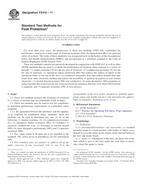Potrebujeme váš súhlas na využitie jednotlivých dát, aby sa vám okrem iného mohli ukazovať informácie týkajúce sa vašich záujmov. Súhlas udelíte kliknutím na tlačidlo „OK“.
ASTM F2412-11
Standard Test Methods for Foot Protection
Automaticky preložený názov:
Štandardné Skúšobné metódy pre ochranu nôh
NORMA vydaná dňa 1.7.2011
Informácie o norme:
Označenie normy: ASTM F2412-11
Poznámka: NEPLATNÁ
Dátum vydania normy: 1.7.2011
Kód tovaru: NS-53798
Počet strán: 17
Približná hmotnosť: 51 g (0.11 libier)
Krajina: Americká technická norma
Kategória: Technické normy ASTM
Kategórie - podobné normy:
Anotácia textu normy ASTM F2412-11 :
Keywords:
chain saw protection, conductive footwear, dielectric, electric shock resistance (EH), foot protection, impact resistance, metatarsal protection, protective footwear, puncture resistance, safety footwear electrical hazard, static dissipative (ESD, ICS Number Code 13.340.50 (Leg and foot protection)
Doplňujúce informácie
| Significance and Use | ||||
|
These test methods contain requirements to evaluate the performance of footwear for the following: Impact resistance for the toe area of footwear (I/75), Compression resistance for the toe area of footwear (C/75), Metatarsal protection that reduces the chance of injury to the metatarsal bones at the top of the foot (Mt/75), Conductive properties which reduce hazards that may result from static electricity buildup, and reduce the possibility of ignition of explosives and volatile chemicals (Cd), Electric Hazard by stepping on live wire (EH), Static dissipative (SD) properties to reduce hazards due to excessively low footwear electrical resistance that may exist where SD footwear is required, and Puncture resistance footwear devices (PR). Any changes to the original components of safety toe footwear such as replacing or adding after market footbeds/inserts could cause non compliance to any or all parts of this standard rendering the ASTM label invalid. Protective toe footwear specimens or samples shall be retested for any of the following changes. Change in material used to make protective toe cap, change in protective cap manufacturer, change in the design of the toe cap. Change in construction method used to make footwear or change in factory in which footwear is produced. Change in the upper or insole material thickness greater than 25 %, change to the soling system or a change in the hardness of the outsole. Change in shape of last used in the manufacturing of footwear. Change in material or supplier of protective insole. Change in material or supplier of met guard. |
||||
| 1. Scope | ||||
|
1.1 These test methods measure the resistance of footwear to a variety of hazards that can potentially result in injury. 1.2 These test methods may be used to test for compliance to minimum performance requirements in established safety standards. 1.2.1 By agreement between the purchaser and the supplier, or as required by established safety standards, these test methods can be used to determine any one, or all of the following: (1) impact resistance (I), (2) compression resistance (C), (3) metatarsal impact resistance (Mt), (4) resistance to electrical conductivity (Cd), (5) resistance to electric hazard (EH), (6) static dissipative performance (SD), and (7) puncture resistance (PR). 1.3 The values stated in SI units are to be regarded as the standard. The values given in parentheses are for information only. 1.4 This standard does not purport to address all of the safety concerns, if any, associated with its use. It is the responsibility of the user of this standard to establish appropriate safety and health practices and determine the applicability of regulatory limitations prior to use. |
||||
| 2. Referenced Documents | ||||
|
Podobné normy:
1.1.1986
NEPLATNÁ
1.1.1987
1.7.1990
1.7.1992
1.1.1980
1.1.1979
Odporúčame:
Aktualizácia technických noriem
Chcete mať istotu, že používate len platné technické normy?
Ponúkame Vám riešenie, ktoré Vám zaistí mesačný prehľad o aktuálnosti noriem, ktoré používate.
Chcete vedieť viac informácií ? Pozrite sa na túto stránku.



 GOST 12.4.162-85..
GOST 12.4.162-85..
 Cookies
Cookies
